Livebearing fish are species that give birth to live young, unlike the majority of fish species they do not lay eggs which are left to hatch. Some sharks and stingrays give birth to live young amongst others, but the average aquarium enthusiast is much more likely to associate the term livebearer with small, colourful fish originating from Central and South America.
If you’ve found yourself on the INJAF website it’s pretty much guaranteed that you’ll be familiar with some livebearing aquarium fish species. You obviously have an interest in ornamental fish and so names such as guppy, molly and platy will almost certainly be familiar to you and these are the fish that this article will focus on.
These smaller, brightly coloured fish are the cornerstones of the bread and butter species found in pretty much every single LFS and need little introduction. However they don’t always make the greatest choice for every tank. They can breed like rabbits and don’t do well in soft water aquariums. Perhaps also more worryingly is that we have witnessed a severe decline in the health and quality of mass produced examples of some species. So INJAF have put together a guide to help those wanting to keep and breed these fish in order to assist you finding the best fish and getting the best from them.
Common Name: Guppy
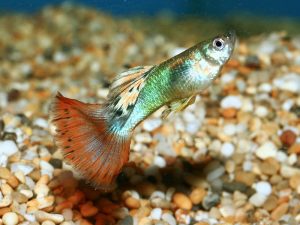
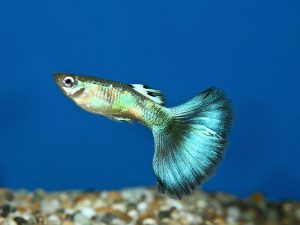
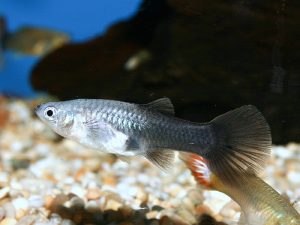
Scientific Name: Poecilia reticulata (Peters, 1859)
Synonyms (Outdated scientific names): Lebistes poeciliodes (De Filippi, 1861; Girardinus guppii Günther, 1866)
Maximum Size: Male 5 cm. Female 6 cm for aquarium strains. Wild fish are a little smaller.
Temperature: 18 c to 28 c. Bear in mind that guppies will tolerate higher temperatures but these can shorten life expectancy. We recommend avoiding temperatures in their higher range if other tank mates don’t require this.
pH: 7.0 to 8.5
Hardness: 140 to 500 ppm
Tank setup: At least 50 litres, preferably more. Well planted, even heavily planted. Floating plants are appreciated, particularly by young fry, also using a substrate which helps keep the water hard is ideal as this species will not thrive in soft water. Avoid very strong currents in the aquarium.
Feeding: Tank bred fish will accept a wide range of commercially produced aquarium fish foods. Flake food, freeze dried foods will be readily accepted as will frozen and live foods such as daphnia, artemia, blood worms and grindal worms to name a few.
Distribution: Found throughout the Southern Caribbean and North Eastern reaches of South America. It’s natural habitat would include Guyana, French Guiana, Suriname, Venezuela, Antigua, Barbados, Trinidad and Tobago as well as throughout the Netherlands Antilles. However, invasive populations are now found in almost sixty other countries worldwide. Many deliberate introductions have taken place as part of planned malaria control as these fish love to feed on mosquito larvae. That said, reports suggest these feral populations have had at best a negligible impact on resident mosquito populations.
***INJAF Random Fact***
Believe it or not a feral population of guppies once thrived here in the UK after a selection of tropical fish were illegally introduced into the St Helens canal in St Helens. A Pilkington’s glass factory used to cycle water from the canal as part of its cooling process. The warm waters made it possible for them to survive here. It is believed that all of these fish have now been removed.
Notes: Read any book on fishkeeping that’s ten years or older and you’ll find the guppy described as hardy, an easy to keep and breed species ideal for the beginner. Fast forward a couple of decades and things are very different. The problem with today’s farmed guppies is that most have been inbred over decades to produce a plethora of different colour and shaped strains.
They are now produced en masse in Far Eastern fish farms. These genetically weak, poor quality fish are often produced in hard water or even brackish conditions so that the farms can grow them on as quickly as possible. Sadly this results in these poor quality specimens suffering when they reach hobbyists or even dealers tanks containing different water chemistry. To add insult to injury they often reach their country of importation in a diseased state and require heavily medicating in the wholesalers tanks. Regrettably, a lot of these fish will reach the home aquarist before being fully treated. This species now results in heavy losses in the hobby and ‘Far Eastern farmed guppies’ can no longer be described as hardy.
All is not lost though. Thankfully there are many committed breeders of quality guppies in the UK and it is possible to find great looking fish without the acclimatisation or disease problems from farmed fish. We advise you to seek out quality UK bred guppy fish where possible. Details of relevant associations can be found at the end of this article.
Wild type guppies are occasionally offered for sale. These tend to be smaller than aquarium strains with comparably drab colouration. Both true wild caught fish and their offspring F1 and F2 generations etc can sometimes be found for sale on websites such as Aquarist Classifieds and even ebay as well as being offered by aquarium club members at their subsequent auctions.
Sexual dimorphism: Guppies are one of the easiest species of fish to sex. Females are larger and have a more rounded body. Males have a modified, stick like anal fin called a gonopodium. This is used to impregnate female fish. Males also have elongated finnage. This can be quite variable depending on the strain of tank bred fish.
With wild fish, males are more colourful as females tend to be a drab silver colour. The same is also true with tank bred strains. However after generations of selective breeding tank bred strain females are now also colourful.
Breeding: Guppies are also called ‘millions fish’ and with good reason. They have a very high rate of fecundity and will reproduce quickly from a very early age. All the aquarist has to do is keep males and females together and fully formed tiny fry will appear in due course. We would recommend you keep several females to each individual male as single females will be hounded by interested males causing them stress.
Once mated, gestation takes around 28 days. A single female can give birth to between 5 and 80 fry depending on age and her size. Larger broods are occasionally reported. Pregnant or gravid females are very easily identified by their gravid spot. This is a darkened area just behind the fishes belly. The female fry will be sexually mature at three months the males a little sooner.
Females can retain sperm for around nine months after an initial mating and so can continue to produce fry for some time even after being separated from any males in the aquarium and is one reason why this species is so prolific.
Newly born fry are large enough to accept finely crushed flake, newly hatched brine shrimp and commercially produced fry food such as Interpet Number 2 livebearer fry food.
Helpful tips from INJAF for this species include:
If you don’t want a tank full of guppies consider purchasing male only fish. Many female fish will already be pregnant by the time they reach your local fish store. In just a few months they will have given birth and the offspring started to inbreed resulting in potentially unwanted poor quality fish.
If you don’t want your baby fry eaten by their tank mates, plant a lot of fine leaved plants in the tank such as Cabomaba or Elodea densa as well as adding floating species such as Salvinia natans. This will give the fry a hiding place and a chance for them to grow on before being preyed upon. This is preferable to the small breeding traps which are available. I’ve noted that it tends to be larger females that prey upon fry. Males rarely seem interested as do smaller female guppies.
Don’t keep these fish in soft water. Although they may tolerate it they really need hard water in order to thrive. Avoid completely if your Ph is below 6.
Don’t keep these fish with fin nipping species such as tiger barbs or Siamese fighting fish as their bright tails make attractive targets for these more aggressive species. Male guppies and Siamese fighting fish is an accident waiting to happen.
Seek out quality fish produced by UK specialist breeders or even wild type fish if you want healthy and genetically strong fish. We recommend you avoid mass produced farmed guppies.
Common Name: Endler’s Livebearer
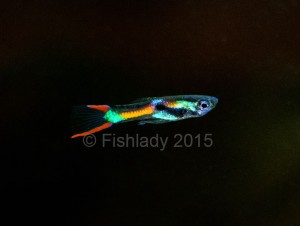
Scientific Name: Poecilia wingei (Poeser, Kempkes & Isbrucker 2005)
Synonyms (Outdated scientific names): (Poecilia (Acanthophacelus) wingei Poeser, Kempkes & Isbrucker, 2005)
Maximum Size: Male 2.5 cm. Female4.5 cm
Temperature: 24 c to 30 c. Endlers enjoy warmer temperatures than guppies. Therefore they are unsuitable for tanks without an aquarium heater.
pH: 7.0 to 8.5
Hardness: 15 to 25 degrees.
Tank setup: At least 50 litres, ideally larger. Again this species will appreciate a well planted tank featuring floating species of plants. Despite their small size they require plenty of swimming space!
Feeding: Unfussy, this species will accept a wide range of commercially produced aquarium fish foods. Flake food, freeze dried foods will be readily accepted as will frozen and live foods such as daphnia, artemia, blood worms and grindal worms to name a few.
Distribution: Found only in Venezuela, specifically in freshwater lagoons in Buena Vista and Campoma and Carupano. There are unverified reports that this species is now extinct in the wild due to pollution of its native habitat. However at the time of writing this is disputed by some who claim the species can be found in other areas.
***INJAF Welfare Tip***
The hobby has been plagued by manufacturers producing small nano tanks in recent years. These are more lifestyle products than suitable aquaria. Whoever designed many of these tanks had interior design in mind rather than the needs of fish. We have since seen many people asking what fish species are suitable for their new 9.2 litre nano tank. Rather worryingly endlers are often suggested due to their small size. These are active fish and will swim around for hours on end and thus need plenty of swimming space. Therefore do not keep these fish in tiny tanks. For a group of these fish look at 60 litres plus.
Notes
Endlers are relatively new to the aquarium hobby when compared to guppies, platties and mollies etc. There has been much debate as to whether or not they are a true species. Initially it was thought that they were a type of guppy but in 2009 it was determined that they are a separate species. Part of the confusion was caused by the fact that Endlers will hybridise readily with guppies and produce fertile offspring. In fact it is claimed by some that some wild fish found in Venezuela are already hybrids of the two species.
Endlers were originally discovered in 1937 by Franklyn Bond and then almost forgotten. The species was then rediscovered in 1975 by John Endler and given their common name.
They are similar in appearance to the common guppy but there are subtle differences. First of all this is a smaller species. P wingei males have a metallic colouration whereas P reticulata has a matte colouration. Often male Endlers have colouration along the edge or edges of their caudal fin (tail) giving the appearance of a sword. Endlers have a smaller dorsal fin and are not as stocky as guppies having a more slender body shape. As for females, Endlers tend to have darkened rims around their scales whereas female guppies do not.
Careful examination of the gonopodium will also reveal just one hook and a pointed end in Endlers but multiple hooks and a rounded end in male guppies. Brood sizes are much smaller in Endlers producing broods which rarely exceed 15 in number, whereas broods in guppies of 100 have been reported.
Most of the fish available in the aquatics trade originate from two main collectors who visited Venezuela. These were Armando Pou in 2004 to 2006 and Phillip Voisin in 2011. In time these fish were bred in commercial numbers and distributed throughout the hobby. One aquarist of note is US based Adrian Hernandez who has produced wild type strains, tank bred strains and guppy x Endler hybrid fish for the aquarium hobby.
Hernandez exported many true Endlers to Europe which helped people obtain and cultivate pure strain Endler fish. To ensure people knew if their fish were true endlers or hybrids he developed his own classification scheme. This is not universally accepted globally but is popular in the US and is included here to educate those new to this species if they come across the terms :-
N class – Are true strains of P wingei where the origins of the fish can be traced right back to the initial collections. This can include tank bred strains and is not limited to wild types.
K class – These are hybrid fish which are the result of Poceilia wingei x Pocelia reticulata hybrids. Fish sold as Tiger Endlers, Paradise Endlers and Yellow Jacket Endlers are some types of K class hybrids.
P class – These are fish of Endler appearance which cannot have their origins verified. They may or may not be true Endlers.
Sadly most ‘Endlers’ offered for sale in UK fish shops are actually hybrids of these two species. Mass produced aquarium strains contain guppy DNA originating in Far Eastern fish farms. Thankfully there are a few specialist breeders producing both wild type strains as well as tank bred strains.
Sexual dimorphism: Like guppies, females are larger and exhibit dull colouration. The smaller and more slender males have bright metallic colouration and possess a gonopodium., a modified anal fin used for reproduction.
Breeding: This is a very easy species to breed. The aquarist needs only to provide a suitable environment and inevitably fry will appear. Again like guppies it is preferable to have a surplus of females to males to prevent unnecessary stress. Male Endlers will perform a ‘dance’ before breeding unlike guppies.
Once mated, gestation takes between 23 and 24 days. A single female will produce broods of between 5 and 25 fry with 15 being about average. Gravid females are identified by their ‘gravid spot,’ a darkened area just behind the fishes belly. If well fed the female fry will be sexually mature at three months the males a little sooner. Like many other Poeciliid livebearers females can retain sperm to produce fry for up to a year according to some reports.
Newly born fry are large enough to accept finely crushed flake, newly hatched brine shrimp and commercially produced fry food such as Interpet Number 2 livebearer fry food.
Helpful tips from INJAF for this species include:
Seek out pure bred Endlers from UK based specialist breeders. If at all possible avoid the hybrid fish found in typical aquarium stores. Although they may cost a little bit more we believe they are well worth it. Keeping pure strains of species which face extinction alive and well in the hobby can only be a positive thing.
If you don’t want a tank full of Endlers, consider purchasing male only fish. Many female fish will already be pregnant by the time they reach your local fish store. In just a few months they will have given birth and the offspring started to inbreed resulting in potentially unwanted poor quality fish.
Do not keep this species in an unheated aquarium. They require warmer temperatures that other commonly kept livebearers.
Avoid soft water. These are a hard water species. Check your Ph and do not purchase if you have acidic water.
Ensure your aquarium has a tight fitting lid. Like many killifish species, Endlers have a habit of launching themselves out of the tank. They are unfortunately able to propel themselves through the smallest gaps too so bear this in mind when choosing an aquarium for them.
Like guppies you should avoid keeping Endlers with fin nipping species.
Common Name: Platy

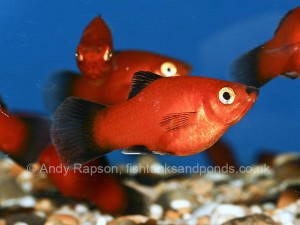
Scientific Name: Xiphophorus variatus (Meek 1904)
Synonyms (Outdated scientific names): Platypoecelius variatus (Meek 1904)
Maximum Size: Male 5 cm. Female 7 cm though usually smaller.
Temperature: 20 c to 26 c. Some people believe platy fish can be kept in cold water however INJAF recommends the installation of an aquarium heater keeping the water heated to a minimum of 20 c.
pH: 7.0 to 8.3
Hardness: 14 to 30 degrees.
Tank setup: At least 60 litres, ideally larger. This species will enjoy living in a heavily planted tank with suitable plant species.
Feeding: The platy like the livebearers mentioned above is also omnivorous. They are unfussy and will readily accept flake food, freeze dried food and of course live and suitable sized frozen food. Feed a varied diet for best results.
Distribution: Native to the Atlantic side of Mexico. Though introduced feral species now exist in Colombia, Costa Rica, Hawaii, Hong Kong, Mexico, Puerto Rico, Singapore and the US.
***INJAF Random Fact***
It is highly unlikely that the platy’s seen in your local aquarium shop are a true species. They are likely to be hybrids of Xiphophorus variatus and Xiphophorus maculatus or Xiphophorus helleri.
Notes
The humble platy is one of the most popular and easily kept species of tropical fish. Selective breeding has resulted in many different varieties, many of which are hybrids as previously mentioned. Unfortunately this has resulted in poor quality fish due to inbreeding and leaves many fish susceptible to disease.
Wild type fish are rarely seen for sale in the hobby though are available occasionally from specialist breeders.
The genus Xiphophorus translates as ‘without sword’ and allows the aquarist to easily tell the difference between related swordtails.
Sexual Dimorphism: Males are smaller and possess a gonopodium. There are no differences in colouration with this species.
Breeding: Simple. Just add a few females to every male and let nature take its course. A heavily planted tank is appreciated by this tank and dense planting will help protect new born fry from predation from other tank mates. Gestation can take longer than other livebearing species lasting between 28 to 49 days. Broods can on occasion number over 100 fry.
New born fry are again unfussy and will take crumbled flake, microworms, newly hatched brine shrimp and commercially prepared fry foods.
Helpful tips from INJAF for this species include:
Due to inbreeding we recommend that you take extra care to select healthy platy fish. If fish look sick or weak in dealers tanks walk away.
Keep this species in a heavily planted tank.
Common Name: Black Molly
Scientific Name: Poecilia sphenops (Valenciennes, 1846)
Maximum Size: Male 8 cm. Female 12 cm though usually much smaller.
Temperature: 21 c to 28 c.
pH: 7.0 to 8.4
Hardness: 15 to 30 dH
Tank setup: At least 80 litres. This species requires a larger aquarium than other popular livebearers. This species will appreciate a planted tank and absolutely must have hard alkaline water. If kept in acidic water they will fade quickly and ultimately die.
Feeding: Black mollies are omnivorous. They are unfussy but should be given a vegetarian flake of spinach in addition to usual freeze dried, live and frozen foods. They need their greens!
Distribution: Black mollies are native to Mexico, Venezuela Colombia, Curacao and the Cooke Islands. Feral populations can also be found in Indonesia, Japan, Philippines, Singapore, Trinidad, Tobago, Hawaii, Brazil and perhaps more surprisingly in parts of Eastern Europe where they are mass produced for the aquatics trade in Hungary, Czech Republic and Slovakia.
Notes
Black mollies are a striking and very popular aquarium favourite. Unfortunately they are often purchased by aquarists who are unaware of their requirements. This is a species which will simply not survive in acidic aquariums for any length of time. They must be kept in hard alkaline water in order to survive. They can also be kept quite happily in brackish and even full marine aquaria.
Several tank strains exist. Black, green, gold and dalmation are regularly seen for sale. Some of these will have been achieved by the hybridisation with the related species Poecilia latipinna.
***INJAF Welfare Tip***
Sadly the aquatics industry has produced a balloon molly. This strain is known to suffer from digestive and swim bladder problems and is guaranteed to not achieve a natural life expectancy, therefore INJAF strongly advice that you do not purchase balloon mollies.
Sexual Dimorphism: Males are smaller and possess a gonopodium. There are no differences in colouration with this species.
Breeding: Easy as long as they are kept in hard alkaline water. As you would expect we would recommend that several females are kept to every male. Gestation takes 28 days plus. Broods of between 20 and 120 fry are produced. New born fry can be fed on crumbled flake, newly hatched brine shrimp, microworms and commercially prepared fry foods for livebearers.
Helpful tips from INJAF for this species include:
If you cannot keep this species in hard alkaline water or even a brackish or marine aquarium do not purchase it. They simply won’t survive in soft acidic water for any length of time.
Do ensure that your black mollies are given vegetable matter in their diet.
Avoid balloon mollies. These man made mutants will suffer due to unethical breeding and will not achieve a natural life expectancy.
Common Name: Swordtail
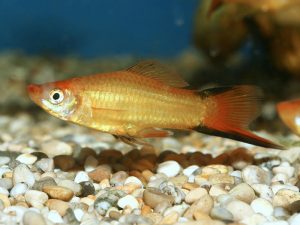
Scientific Name: Xiphophorus helleri (Heckell 1848)
Synonyms (Outdated scientific names): Xiphophorus guntheri Jordan & Evermann, 1896; Xiphophorus jalapae Meek, 1902; Xiphophorus brevis Regan, 1907; Xiphophorus strigatus Regan, 1907; Xiphophorus rachovii Regan, 1911
Maximum Size: Male 8 cm. Female 8 cm.
Temperature: 16 c to 27 c.
pH: 6.5 to 8
Hardness: 90 to 440 dH
Tank setup: A minimum size of 90 litres is recommended, bigger if possible as these fish can be quite active. A planted tank is appreciated to give areas of cover.
Feeding: Swordtails are unsurprisingly omnivorous so feed a good selection of live food, frozen food, regular flake food and spilurina flakes to provide a varied and balanced diet. They will also feed on algae in the aquarium.
Distribution: These days they can be found on every continent other than Antarctica! Their native range is in Belize, Guatemala, Honduras and Mexico but this now extends across the globe and can be found in 34 countries. Fishbase currently show that introduced populations can currently also be found in Madagascar, Mauritius, Namibia, Reunion, South Africa, Hong Kong, India, Indonesia, Israel, Japan, Singapore, Sri Lanka, Taiwan, Czech Republic, Hungary, Slovakia, Bahamas, Guadeloupe, Jamaica, Martinique, Puerto Rico, USA, Australia, Fiji, Guam, Hawaii, New Caledonia, New Zealand, Papua New Guinea, Brazil and Colombia.
Notes
Due to their huge range green swordtails can be found in a wide variety of habitats. In their native range they often inhabit environments with little or even no vegetation and so do not appreciate a planted tank like platy fish do.
Selective breeding has resulted in many colour variants and fins with different fin types. Hybridisation has occurred with closely related species in order to create these man made strains.
Swordtails are an easy species to keep and are often recommended for beginners. That said inbreeding has resulted in some genetically weak examples and so aquarists are advised to seek out healthy specimens. Wild fish are occasionally offered for sale and are highly recommended if you have the opportunity to purchase any.
Sexual dimorphism: Males are smaller than females and possess a gonopodium. Males also exhibit an extension of the lower caudal fin (tail) lobe. This extension gives them their common name swordtail. Some aquarium strains have been produced resulting in extensions of both the top and bottom caudal lobe. These can be present in both sexes, so to be sure we recommend you look for the gonopodium to be absolutely sure.
Breeding: Very similar to the closely related platy species of which they are known to hybridise with. Again, keep a number of females to a single male. Gravid females will exhibit a gravid spot. Gestation takes around 28 to 35 days with a brood size of between 20 to 100 fully formed fry. Care for new born fish is the same as it is for platy fish. Female swordtails can retain sperm for months and produce several broods in the absence of male fish.
Helpful tips from INJAF for this species include:
With the four previously mentioned species we have pointed out that hard alkaline water is needed for those species to thrive. Swordtails on the other hand can be kept in neutral water or even slightly acidic aquaria. So if you don’t have a hard water aquarium but want to keep livebearers, then this is probably the species for you.
Due to inbreeding we recommend that you take extra care to select healthy platy fish. If fish look sick or weak in dealers tanks walk away.
What do I do with my livebearer fry?
Good question and one you should spend time thinking about before you choose to purchase male and female livebearers. We can make some suggestions for you here, but if these don’t appeal or are not possible, then please stick to purchasing male fish only and you won’t have the headaches of deciding what to do with your inevitable fry.
Firstly, you’ll never see anyone on the TV show Dragons Den stating that they want to set up a business commercially breeding guppies and mollies. These fish are produced in Far Eastern fish farms and are imported for pennies. So if you’re thinking of profiteering from fish breeding, these are not the fish to choose. So here a few options you could try:
Give them away to a new home. Perhaps you have friends who have room for a few more fish?
Give them to your local aquarium shop. Though here’s the rub, they might not want to pay you for them. If they offer you a small token store credit, take it and consider this a positive result. The truth is they are offered home bred fish regularly and so don’t need to pay anyone desperate to get rid of their fish.
You can however improve your chances of selling them or achieving store credit if you supply healthy, good sized and attractive fish. Make sure they are well grown on before offering them to a shop. Take a look at the sizes they have for sale and make sure yours are at least as big. Ensure that all are healthy and only offer fish with good body shape, finnage and colour. The truth is that if you’ve previously bought ‘Heinz 57’ type platties for example, then some of your offspring may not be of great quality. With this in mind it would be advisable to selectively breed your fish ensuring that potential brood stock is of the highest quality you can obtain. Buying your initial fish from established breeders, perhaps at a local club auction is a very good idea as these fish will be of superior quality to the ones you find in shops. Their provenance will also be a potential selling point.
You could try selling your fish at a local fish club auction. Many local clubs regularly have auctions where breeders can sell surplus stock. They’re also a good place to meet fellow, like minded fish keepers and are well worth a look.
Try moving your fish online. Websites such as www.aquarist-classifieds.co.uk or even groups of Facebook could be worth a go. There has been an explosion of fish related groups on Facebook. Take a look and see if there is one based locally.
Your next steps
Have we got you interested? Would you like to know more? Do you fancy keeping some of the more unusual species of livebearer? Unfortunately it would be almost impossible to cover every species and aspect of their care on this website so here a few helpful links to help you learn more about livebearers.
British Livebearer Association also on Facebook: British based club dedicated to the keeping and breeding of livebearer species
Guppy Club of Great Britain: A club dedicated to showing guppies in the UK
Fancy Guppies UK: A club dedicated to breeding and showing guppies
Author: Jared Cave
Photos courtesy of Fishlady and Andy Rapson at Fishtanksandponds.co.uk




